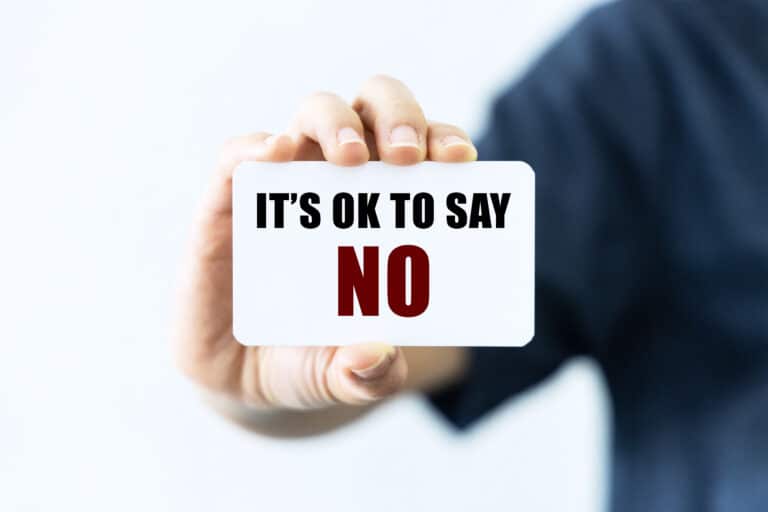Article Summary:
Many leaders agree too quickly to the many requests they receive. Such frequent assent can undermine key priorities. Good leaders learn to say no. Here’s how.
+++
Many of us are bombarded with requests, opportunities, and decisions to make. Our subordinates and colleagues make compelling cases for things they want or need, and we want to support them. But it’s too easy to get drawn into agreeing too often, undermining our ability to address more important priorities.
It’s easier to say “yes” to our employees and associates than “no.” We don’t want to be negative, especially to those we care about. But as leaders, we have the responsibility to lead well and achieve the needed results. Otherwise, our tenure as leaders will be short.
Why This Is Difficult
Many leaders know this conceptually, but that doesn’t make it easy. There are many reasons why this can be a big challenge for many leaders.
Our employees can make compelling pleas for our approval for a new idea. We don’t want to dampen their enthusiasm, but a yes risks taking our focus off critical goals.
Some leaders blurt out “yes” to requests without taking the time to think them through. It may even be instinctive—or drilled into them from childhood. In other cases, they agree to things to avoid conflict or hassles, only to regret it later.
Saying no may be difficult if we struggle with self-doubt or “impostor syndrome,” which is not rare among leaders, or if we’re needy for approval and appreciation from others. Also, we may feel guilty for turning our people down and afraid they may not like us.
Clearly, there are many factors that can push us toward “yes.”

Leadership Derailers Assessment
Take this assessment to identify what’s inhibiting your leadership effectiveness. It will help you develop self-awareness and identify ways to improve your leadership.
Beware the Yes Tax
With all the factors pushing us toward “yes,” we should be vigilant in remaining mindful of the “yes tax.” There’s a price to be paid for our assent.
Saying yes too often takes the focus off critical priorities. It can dilute efforts and lead to poor results. Agreeing to too many things can work against our quest for excellence, and it can dilute our innovation efforts.
“People think focus means saying yes to the thing you’ve got to focus on. But that’s not what it means at all. It means saying no to the hundred other good ideas that there are. You have to pick carefully. I’m actually as proud of the things we haven’t done as the things I have done. Innovation is saying no to a thousand things.”
-Steve Jobs, co-founder and former CEO, Apple
When we say yes too much and too quickly, we can allow our employees to diverge from what really needs to be done and get:
- overcommitted
- stretched too thin overpromise and underdeliver
- make mistakes or drop the ball on other important tasks, causing trouble for others
- harm our credibility
How to Go About It: Tips for Saying “No” Gracefully
Learning to say no without alienating people is a learnable skill. It just takes a new mindset and lots of practice. Here are some tips for going about it:
Start by going back to our top priorities. Make sure we know what’s most important and why, so you can respond to the request in its proper context. What are we committed to? What results are imperative, and what are our ethical boundaries?
“You have to decide what your highest priorities are and have the courage—pleasantly, smilingly, non-apologetically—to say ‘no’ to other things. And the way you do that is by having a bigger ‘yes’ burning inside.”
-Stephen R. Covey, author, executive, and teacher
Realize that focus is one of the key drivers of success. Focused attention is needed to execute well. (See our article, “How Good Leaders Drive Execution in Their Organization.”) Having too many priorities and goals just confuses people. It’s better to be a yard deep on the critical issues and only a few inches wide than an inch deep on a host of issues.
“The difference between successful people and really successful people
is that really successful people say ‘no’ to almost everything.”
-Warren Buffett, legendary investor and philanthropist
Assess the request and the motives and context of the person asking. Ask questions and gather information. In his Harvard Business Review article, management author and consultant Bruce Tulgan advises being thorough—especially when the request is more complex. Consider asking things like the following:
- What would be entailed with meeting the request?
- What’s the deadline?
- What resources are needed?
- What are the potential benefits?
- What are the costs, including time, resources, and effort?
- Is there a risk of scope creep?
- How does this request fit in with other requests and our top priorities?
- Is it aligned with the organization’s shared purpose, values, and vision—and with its strategy, goals, and current priorities?
Don’t feel obligated to respond right away. Sometimes, it’s wise to buy time so we can think about it and avoid the pressure of the moment, especially if we’re trigger-happy with our approval.
Note that there are different versions of “no,” ranging from not right now to never. Pause to consider different options.
Don’t forget to account for the opportunity cost. By agreeing to one request from a subordinate , we’re foregoing a host of other possible uses of their time.
“Every good no makes room for a better yes—one that adds value, builds relationships, and enhances your reputation.”
-Bruce Tulgan, “Learn When to Say No,” Harvard Business Review, September–October 2020
Recognize that saying “no” can get easier over time, especially if we work on our decision-making process and reasoning.
Be as clear as possible. Sometimes, we downplay things in an effort to avoid hurting people’s feelings, but all we end up doing is confusing them and leaving room for misinterpretation and resentment.
Be assertive. We should be respectful, of course, but firm and assertive.
“Stop Doing” list. We have found value in using a “Stop Doing” list along with our “To Do” lists. We endorse that practice. It’s useful when a subordinate asks for more money or staff to ask them to bring you a list of things they’ll stop doing to free up resources for the new request.
Consider when to turn the request around. Our employees may be tempted to ask for what’s easiest for them (e.g., more resources), and they may not have the full picture of resource constraints and competing priorities. Saying no can force them to find or create innovative solutions. When someone asks for something, consider asking them for innovative ideas for how they might accomplish their work instead of what they requested.
Recognize that saying no can sometimes bolster our credibility. People see that we’re committed to the larger purpose, values, and vision. They respect us for prioritizing and communicating clearly and forthrightly—and for setting boundaries.
Recall that setting boundaries is important for our own health and wellbeing.
“Saying no is one of the best forms of self-care we can engage in.”
-Dr. Nicole Washington, board-certified psychiatrist
Saying yes. Of course, leaders can’t be negative nellies. Sometimes new requests are great ideas to achieve the primary goals more effectively. Then an enthusiastic yes is warranted. Leaders want to avoid becoming negative and discouraging even as they work to protect the top priorities.

Alignment Scorecard
When organizations aren’t aligned, it can reduce performance dramatically and cause frustration and dysfunction. With this Alignment Scorecard, you can assess your organization’s level of alignment and make plans for improving it.
Conclusion
In the end, deciding when to say yes versus no is an essential aspect of leadership. It requires judgment and wisdom—and sometimes courage. Sometimes the difference between success and failure is the difference between yes and no.
Successful leaders find constructive ways to say no when needed so they can remain focused on their top priorities.
“You must… learn when and how to say both no and yes. A considered no protects you. The right yes allows you to serve others, make a difference, collaborate successfully, and increase your influence. You want to gain a reputation for saying no at the right times for the right reasons and make every single yes really count….
The only way to be sustainably successful is to get really good at saying no in a way that makes people feel respected and to say yes only when your reasoning is sound and you have a clear plan of attack.”
-Bruce Tulgan, “Learn When to Say No,” Harvard Business Review, September–October 2020
(For examples of different ways to turn down requests, see the Appendix below.)
Reflection Questions
- Do you say yes too often to requests from your employees?
- Is it time to start declining requests more often so your organization can stay focused on top priorities?
- Will you challenge employees and colleagues to find creative new solutions to their challenges?
- When will you start?
Tools for You
- Leadership Derailers Assessment to help you identify what’s inhibiting your leadership effectiveness
- Personal Values Exercise to help you determine and clarify what’s most important to you
- Alignment Scorecard to help you assess your organization’s level of alignment

Leadership Derailers Assessment
Take this assessment to identify what’s inhibiting your leadership effectiveness. It will help you develop self-awareness and identify ways to improve your leadership.
Appendix: Ways to Say No
The simplest way to decline a request is to say “no” and leave it at that.
“‘No’ is a complete sentence.”
-Anne Lamott, writer, teacher, and activist
Sometimes that’s too abrupt. A milder alternative: “Unfortunately, we can’t do that now. It takes our focus off our key priorities.”
“Part of the skill of saying ‘no’ is to shut up afterward and not babble on, offering material for an argument.”
-Judith Martin, columnist and writer
We can give a brief explanation, if we want to, but it should be short, sweet, and to the point. Avoid long-winded explanations like the plague.
Examples of saying no when it’s only the timing that isn’t right:
- “We just can’t fit this in right now.”
- “We can’t take that on right now given everything we need to do.”
Related Articles and Books
- “How Good Leaders Drive Execution in Their Organization”
- “People-Pleasing: Why We Do It and How to Stop It”
- “The Problem with Lacking Clarity in Your Life”
- “The Problem with Lack of Focus—And How to Fix It”
- “Are You Focusing Too Much on Other’s Needs?”
- Natalie Lue, The Joy of Saying No
Postscript: Quotations
- “The art of leadership is saying ‘no,’ not saying ‘yes.’ It is very easy to say ‘yes.’” -Tony Blair, former Prime Minister of the United Kingdom
- “A ‘no’ uttered from the deepest conviction is better than a ‘yes’ uttered merely to please—or worse; to avoid trouble.” -Mahatma Gandhi, Indian lawyer and transformational leader
- “A life of commitment means saying a thousand noes for the sake of a few precious yeses.” -David Brooks, The Second Mountain
- “Let today mark a new beginning for you. Give yourself permission to say ‘No’ without feeling guilty, mean, or selfish.” -Stephanie Lahart, author
- “You can be a good person with a kind heart and still say ‘no.’” -Lori Deschene, author

Triple Crown Leadership Newsletter
Join our community. Sign up now and get our monthly inspirations (new articles, announcements, opportunities, resources, and more). Welcome!
+++++++++++++++++++++++
Gregg Vanourek and Bob Vanourek are leadership practitioners, teachers, and award-winning authors (and son and father). They are co-authors of Triple Crown Leadership: Building Excellent, Ethical, and Enduring Organizations, a winner of the International Book Awards. Check out their Leadership Derailers Assessment or get their monthly newsletter. If you found value in this, please forward it to a friend. Every little bit helps!


